We're an affiliate
We hope you love the products we recommend! Just so you know, we may collect a share of sales or other compensation from the links on this page at no additional cost to you. Thank you if you use our links, we really appreciate it!
Have you ever seen your dog suddenly kicking his back legs randomly like how a bull would do? This behavior may be confusing to some pet parents and it may raise concerns when it is done repeatedly.
Well, several reasons may make your lovely pup kick out their legs into the air. It’s more probable that they are excited or doing so because of other harmless reasons.
Bull-kicking in dogs can be simultaneous to remove a foreign particle lodged in their paws. For the most part, the causes are harmless and they should not raise a concern unless something disturbing happens.
We did extensive research on this subject and summed up the five common reasons why your dog may engage in this behavior.
Remember if your furry friend is behaving abnormally while showing signs of emotional distress, it always helps to consult your vet for a professional opinion.
Understanding Leg Kicking Behavior in Dogs
Before we dive into the juice of this post, it’s important to understand this behavior in dogs and appreciate why it happens.
Dogs are complex creatures that communicate to us through body language like tail-wagging, and vocalizations like barking or whining.
Sometimes dogs may use their entire body to communicate with us, and with a keen eye, you can identify what your pet is telling you.
In other cases, your dog’s body movements may not seem to pass a clear message, for example when they twitch their body with kicks.

Your furry friend may jiggle their hind leg randomly because it’s an instinctive behavior that stems from their ancestral traits.
As a responsible pet parent, you should always pay close attention to your dog’s behavior to identify signs of skeletal conditions and emotional distress.
You should look closely into your dog when the leg-kicking behavior is accompanied by signs of health problems such as whining.
Why Does My Dog Kick His Back Legs Randomly?
1. Marking territory
One of the most possible reasons why your dog may kick out their leg randomly is because it’s an instinctive scent-marking behavior.
This normally happens after using the toilet but it could also occur randomly. Dogs have merocrine sweat glands in their paw pads which produce very small amounts of sweat.
The sweat excreted contains pheromones that carry a distinctive scent to all dogs. Sudden leg kicks can be an unthreatening way to inform other pets of the claimed territory.
If you notice that your dog kicks the ground after pooping, then it could also be a sign of spreading scent for territorial marking.
This is because dogs may release some liquid from their anal glands after doing their business in the restrooms.
The liquid carries a strong scent specific to an individual dog, therefore this could be a well-meaning sign to alert other dogs of claimed spaces.
2. Your dog is excited
All dogs have their subtle ways of conveying contentment and excitement to their owners. Some dogs may jump on their caregivers, others may get zoomies, while some may kick the hind leg with a flutter.
You can know if your dog is excited if they combine this behavior with other signs of happiness such as tail wagging, smiling, and having a bouncy body wiggle.
This behavior is common among dogs who greet their owners when coming back home from a long day out. They can also kick the ground with their hind legs when playing with toys.
3. Muscle spasms
Muscle spasms, also known as muscle cramps, refer to the rapid or involuntary contraction of the dog’s muscles without regular relaxation.
Your dog may bull-kick because of cramps on their hamstring muscles or quadriceps.
Muscle spasms usually occur after the dog engages in intensive physical activities. Extreme stimulation of the canine musculoskeletal anatomy causes an interruption in the normal muscles’ contraction and relaxation cycles.
Other conditions that may cause spasms include muscle strains, pinched nerves, injuries, neurological disorders, dehydration, and sometimes it’s a side effect of medication.
You can know if your pawed canine friend is experiencing muscle cramps when their stretched-out hind limbs appear twitchy with tremors in the affected areas.
You can confirm the state of your dog’s muscles by touching the affected hind legs to look out for vibrations. Remember that muscle spasms can be painful for dogs especially if it occurs for a prolonged period.
If your dog’s muscles cramp, you can help them out by providing enough fluids, stretching the affected leg, and gently massaging the affected areas.
You can also perform hydrotherapy using warm water/heat therapy to help the muscles in the affected area to relax.
4. Your dog is dreaming
If your furry friend is twitching their feet during sleep, then there’s a high chance that they’re dreaming. Dogs have two phases of sleep, which are Rapid Eye Movement (REM), and non-REM sleep.
Dogs may bring to life what they experienced during the day and light up the events with dreams during the active REM sleep cycle.
5. Medical conditions
Don’t rule out the possibility of medical conditions for your dog’s bull-kicking behavior without an expert opinion from your vet.
Some of the medical conditions responsible for this behavior in dogs include:
a. Degenerative joint disease
Your dog’s feet may twitch at random because of Degenerative Joint Disease (DJD), also known as osteoarthritis.
DJD is caused by the inflammation of the dog’s joints resulting from the deterioration of the cartilage. In normal operations, the cartilage is responsible for smooth movement by protecting bones at the joints.
Cartilage does not contain nerves, which makes it possible for the bones to touch and move against each other without causing pain.

On the other hand, bones have lots of spinal nerves. When the cartilage becomes progressively worn out, the bones will rub against each other and cause pain.
This is what causes inflammation and other signs of arthritis in the affected dogs.
DJD is a progressive condition in dogs, meaning that it occurs over time due to the constant wear and tear of the joints.
Age, malnutrition, previous injuries, and obesity are some of the other reasons that may induce your dog to DJD.
If you’re suspecting DJD as the reason for your dog’s leg-kicking behavior, the following are some of the related symptoms to watch out for:
- Having potty accidents
- Difficulty in walking
- Lameness
- Sleeping more than usual
- Joint swelling
- Unwillingness to jump
- Difficulty getting up
As the disease progresses and the pain becomes more unbearable, your affected pup may decide to kick into the air as a way of relieving discomfort.
Your vet may recommend a specific remedy for joint health to manage this condition and keep the joints in good shape.
b. Medial Patella Luxation
This condition occurs when the dog’s patella ‘knee cap’ slips out of its natural position. In a normal situation, the patella should sit in a groove within the femur and it should not move to the sides.
This condition may affect one knee but, in most cases, it affects both knees in the hindlimbs.
Medial Patella Luxation (MPL) is a probable cause of difficulty in walking and lameness in dogs. This happens when the patella ‘luxates’ – moves out of its grooves.
Luxation of the patella can affect both small and large breed dogs, although it is commonly seen in small breeds such as Chihuahua, Pomeranians, Yorkshire Terriers, Poodles, Pekingese, Boston Terriers, etc.
Large breed dogs with a high risk of suffering MPL are Great Pyrenees, Labrador retrievers, Golden Retrievers, and Akitas.
Your dog’s patella may move out of its natural place because of a traumatic injury, or degeneration of the ligaments within the joint, or it could be associated with your dog’s limb anatomy.
Dogs with luxating patellar may show various signs depending on the severity of the condition. Some of the common signs include:
- Unusual gait
- Holding the legs up
- Abnormal movements
- Hopping and skipping in movements
- Hunched lower back
- Bowlegged hindlimbs (especially in puppies)
- Unwillingness to walk or jump
- Lameness in severe cases.
As this condition progresses with time, the knee will come out of place and eat into the cartilage to expose the bones. This will certainly lead to severe pain and arthritis.
c. Seizures (Neurological Conditions)
A dog with a seizure may kick into the air, and show other symptoms of having abnormal brain activity.
Seizures may occur due to malfunctioning of the cerebral cortex part of the brain. This may result in a loss of control and balance.
A dog with a seizure is likely to show extreme body shakes with contractions. Other signs of dogs with seizures include:
- Collapsing
- Foaming on the mouth
- Lose consciousness
- Chomping
- Troubled walking
- Walking in circles
- Walking sideways
- Falling on the floor
- Unsteadiness
- Twitching
- Excessive Drooling
- May have accidents at home
The severity of the seizure may vary depending on the extent of the effects. Dogs coming out of seizures are likely to show signs of exhaustion, delusion, or being concerned.
Dogs with seizure attacks may take several minutes to hours before they fully recover to gain control and balance.
d. Hip Dysplasia
This is another medical condition that may make your beloved pup kick their legs out when walking as a way of relieving pain. Hip Dysplasia refers to the loosening of the hip joints occurring as the dog grows.
This condition is usually painful to dogs because it stems from the disconnect of the hip joint ball and socket.
Hip dysplasia is a genetic condition and it is most common in large breed dogs compared to the small breeds.
Other minor causes of the abnormal growth of the hip joints include:
- Malnutrition
- Lack of proper exercises
- Environment
- Excessive growth
- Muscle mass
- Hormonal imbalance
Hip dysplasia can be prevented by carefully selecting the right dogs during breeding to ensure that the bad traits are not passed down.
Dogs with hip joint problems may be treated through; physical therapy, limiting exercise, medication, hip and joint supplements, or surgery for severe cases.
How To Determine the Cause of Leg Kicking in Dogs
To effectively determine why your dog is kicking out its legs in the air, you need to observe the exact time they do that and other symptoms as well.
If your dog is wagging and bull-kicking because of happiness or excitement, then there’s no reason to worry.
However, if the kicking behavior is affecting how your dog walks, and they do it while trying to relieve pain, it should raise a concern.
It may help to monitor the frequency in which your dog kicks into the air and check how long it takes before they get back to normal.
If your dog is responding to specific triggers for leg-kicking, then you may want to remove the stimuli to soothe them.
What To Do for Medical Conditions
If you highly suspect that your dog is kicking into the air as a result of a medical condition, you should immediately set an appointment with your vet.
The vet will examine the dog physically and perform relevant diagnostic tests to single out a medical condition.

If your furry friend is found to have nerve damage, then your vet may recommend a professional neurologist to investigate the possibilities of neurological disorders.
If skeletal or muscle problems are suspected, your vet will perform an X-ray to get radiographs to identify physical defects.
Your vet may ask you to record a clear video of your dog when kicking into the air. This may be very helpful during diagnosis.
Frequently Asked Questions
1. Can leg kicking in dogs be a sign of pain?
Yes! An affected dog may kick out their legs as a way of relieving pain from degenerative conditions on the knee or muscle cramps.
2. Should I be concerned if my dog kicks his legs while sleeping?
For the most part, you shouldn’t be concerned if your dog twitches and kicks out their legs during REM sleep. This is a positive indicator that they’re recreating their day’s moments in dreams.
On most occasions, your dog may kick into the air while dreaming and occasionally flick their eyelids.
3. What can I do to help reduce my dog’s leg-kicking behavior?
The first thing is to identify the possible reasons why your dog is bull-kicking. If it’s due to muscle spasms, then you should consider reducing the intensity of physical exercises.
If your dog is leg-kicking because of behavioral reasons such as territoriality, then you may consider retraining them and providing positive outlets for frustration.
Leg-kicking due to medical reasons should be addressed by a professional vet. Take your dog for an early diagnosis and let the vet prescribe an appropriate treatment plan.
4. Is leg kicking always indicative of a medical condition?
No! Leg-kicking in dogs can be caused by medical reasons but it may also come out naturally due to behavioral reasons such as excitement.
We suggest that you watch out for the excesses and observe the other symptoms when your dog kicks into the air.
Whining, crying, and unwillingness to get up may be a sign of medical conditions, but tail-wagging and being bouncy are positive signs of happiness in dogs.
In Summary
In the course of your pet parenting journey, you will notice that your furry friend may sometimes kick his back legs randomly like a bull.
There are several harmless reasons why your dog may jiggle their hindlimbs at random, and there are also some worrying reasons for this behavior.
Have a close look at your dog when they’re twitching by tossing their feet and figure out the other accompanying body language.
If you suspect medical reasons, we suggest that you call your vet immediately for physical assessment and further diagnosis.
Laura is the founder of Furs'n'Paws. She is a also a pet writer and expert with more than 20 years of experience of working with dogs and cats. She developed a very strong love for animals at a young age. Her passion led her to establish a thriving pet sitting and dog walking business in Dubai. As an expert in pet training, behavior, and nutrition, Laura is committed to helping pet owners and pet lovers by offering high-quality information on a wide range of topics.



No responses yet